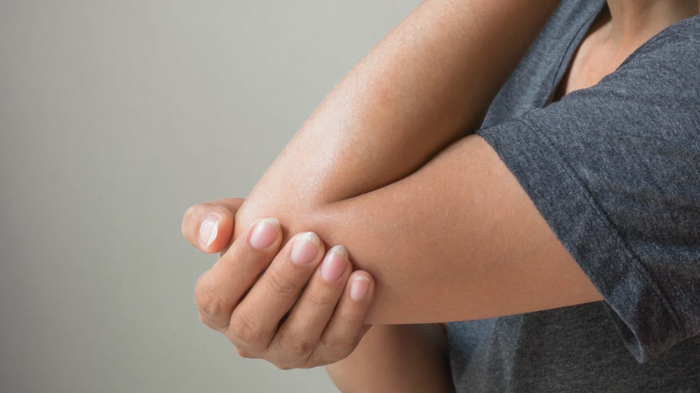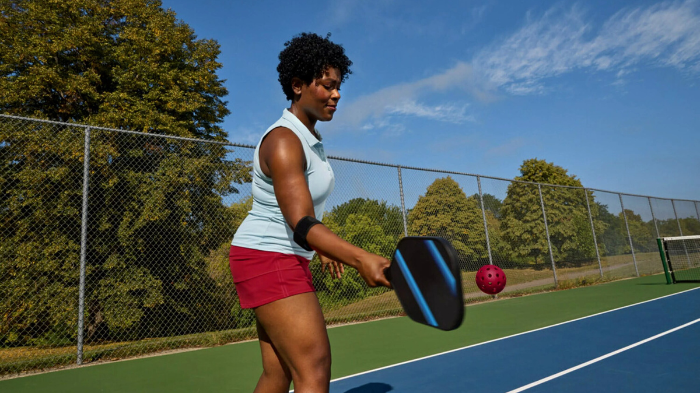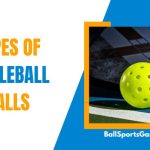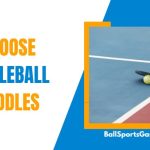One common injury that pickleball players may encounter is the pickleball elbow, also known as lateral epicondylitis or tennis elbow. In this blog, we are going to explain about pickleball elbow, its causes, and symptoms. We are also going to explain how pickleball elbow is treated, tips for preventing pickleball elbow, and when to seek medical attention for pickleball elbow.
Additionally, we are going to tell you how to choose the best pickleball paddle for tennis elbow or pickleball elbow. Whether you’re new to the game or an experienced player, knowing about pickleball elbow and taking preventive measures can prolong your enjoyment and participation in the sport. So let’s start this blog.
What Is Pickleball Elbow?
Pickleball elbow, also known as pickleballer’s elbow or tennis elbow, or lateral epicondylitis, is a condition characterized by pain and inflammation in the elbow joint due to playing pickleball. Pickleball is a paddle sport that combines elements of tennis, badminton, and table tennis. It involves repetitive swinging motions of the arm, which can put a strain on the tendons and muscles in the elbow.
Pickleball elbow is similar to tennis elbow or golfer’s elbow, which are overuse injuries that affect the tendons in the elbow. The condition typically occurs due to repetitive stress or overuse of the forearm muscles and tendons, leading to small tears and inflammation.

Symptoms of pickleball elbow may include:
- Pain or tenderness on the inner side of the elbow (golfer’s elbow) or outer side of the elbow (tennis elbow).
- Weakness in the forearm and grip.
- Difficulty in performing activities that require gripping or lifting.
- Pain that worsens with activity, particularly during swinging motions.
To treat pickleball elbow, it is important to rest the affected arm and avoid activities that worsen the pain. Applying ice packs to the area and taking over-the-counter nonsteroidal anti-inflammatory drugs (NSAIDs) can help reduce pain and inflammation. Physical therapy exercises can also be beneficial for strengthening the muscles and tendons, improving flexibility, and promoting healing.
If the pain persists or becomes severe, it is advisable to consult a healthcare professional or a sports medicine specialist. They can provide a proper diagnosis and recommend additional treatments such as corticosteroid injections, splints, or in rare cases, surgery.
Prevention of pickleball elbow involves using proper technique and equipment, warming up and stretching before playing, avoiding excessive force during swings, and gradually increasing playing intensity and duration. It is also important to listen to your body, take breaks when needed, and maintain overall fitness and strength to support your joints.
What Causes Pickleball Elbow?
Pickleball elbow is primarily caused by repetitive stress and overuse of the forearm muscles and tendons. The specific motions and actions involved in playing pickleball can contribute to the development of this condition. Here are the main factors that can cause pickleball elbow:
Repetitive Arm Movements: Pickleball involves repetitive swinging motions of the arm, particularly during serves, volleys, and backhand shots. These repetitive movements can strain the tendons and muscles in the forearm, leading to microtears and inflammation.
Incorrect Technique: Using improper technique while swinging the pickleball paddle, such as applying too much force, holding the paddle incorrectly, or having incorrect form, can cause extra strain on the tendons and muscles in your elbow. Wrong technique increases the risk of developing pickleball elbow.
Overuse And Intensity: Playing pickleball for extended periods without adequate rest or recovery can increase the risk of developing a pickleball elbow. If you play pickleball too intensely and don’t take breaks to let your muscles and tendons rest and heal, you can end up with injuries caused by overusing them.
Lack Of Conditioning And Warm-Up: Inadequate conditioning and warm-up exercises can contribute to the development of pickleball elbow. Insufficient muscle strength and flexibility and inadequate warm-up routines can make the tendons and muscles more prone to injury.
Age And Pre-Existing Conditions: Older individuals may be more susceptible to pickleball elbow due to natural wear and tear on the tendons and muscles over time. Individuals with pre-existing conditions like arthritis or previous elbow injuries may be at a higher risk.
It is important to note that pickleball elbow can also be caused by factors unrelated to pickleball itself, such as repetitive computer use, manual labor, or other activities that involve repetitive forearm motions.
Learn More: beer city open 2023 And pickleball growth statistics 2023
What Are the Symptoms of Pickleball Elbow?
Typically, the symptoms of pickleball elbow, also referred to as pickleballer’s elbow, include the following:
Pain: You may experience pain in the inner side of the elbow (golfer’s elbow) or the outer side of the elbow (tennis elbow). The pain can range from mild to severe and may worsen with certain movements or activities.
Tenderness: If you touch the affected area, it may be painful and tender, and applying pressure to your elbow can cause discomfort.
Weakness: You might experience decreased strength in your forearm and grip, making it challenging to perform tasks that involve holding or lifting objects.
Stiffness: You may find it challenging to fully bend or straighten your arm because your elbow joint feels stiff and lacks flexibility.
Swelling: Although it is not usually present, swelling around the elbow joint can happen under certain circumstances.
Pain With Activity: The pain may worsen during pickleball or other activities that involve gripping, swinging, or putting strain on the forearm muscles and tendons.
It is important to note that these symptoms can vary in intensity and may develop gradually over time due to repetitive stress on the elbow joint. If you experience persistent or worsening pain or if your symptoms significantly impact your daily activities, it is advisable to seek medical attention for proper diagnosis, treatment and nutrition in pickleball.
How Pickleball Elbow Is Treated?
Treating pickleball elbow, like other forms of elbow tendonitis, usually involves a combination of self-care techniques, conservative treatments, and, in severe situations, medical interventions. Here are common approaches to treating pickleball elbow:
Rest And Modification Of Activity: To help the tendons heal, it is important to give your affected arm proper rest and avoid activities that worsen the pain. You may need to change your pickleball technique or take a break from playing.
Ice Therapy: Applying ice packs to the affected area for about 15-20 minutes several times a day can help to reduce pain and inflammation. Make sure you wrap the ice pack in a cloth or towel to protect your skin.

Pain Medication: Over-the-counter nonsteroidal anti-inflammatory drugs (NSAIDs), such as ibuprofen or naproxen, can help to alleviate pain and reduce inflammation. Follow the recommended dosage and consult a healthcare professional if needed.
Physical Therapy: A physical therapist can develop a personalized exercise program to strengthen the muscles around the elbow, improve flexibility, and promote healing. They can also employ techniques like ultrasound therapy or massage.
Elbow Brace Or Splint: Wearing an elbow brace or splint can provide support, reduce strain on the tendons, and facilitate healing. It may be particularly beneficial during physical activity or while resting.
Corticosteroid Injections: In some cases, a healthcare professional may administer corticosteroid injections directly into the affected area to alleviate pain and reduce inflammation. However, these injections are typically used sparingly due to potential side effects.
Extracorporeal Shock Wave Therapy (ESWT): ESWT involves the application of sound waves to the affected area to stimulate healing and reduce pain. It may be considered for chronic cases that have not responded to other treatments.
Surgical Intervention: Surgery is rarely required for pickleball elbow, but it might be considered if conservative treatments fail to provide relief after an extended period. Procedures can involve removing damaged tissue or repairing the tendons.
It is essential to consult with a healthcare professional or a sports medicine specialist to determine the most appropriate treatment plan based on the severity of your symptoms and individual circumstances. They can provide a comprehensive evaluation and guide you through the recovery process.
How to Get Best Pickleball Paddles for Tennis Elbow?
To find the best pickleball paddle for tennis elbow, you can follow these steps:
Consult With A Medical Professional: Seek advice from a medical professional, such as a sports medicine doctor or physical therapist, who can evaluate your condition and provide specific recommendations based on your needs and limitations.
Research Paddle Features: Look for paddles that are known for their arm-friendly features. Consider factors such as weight, material, grip size, and paddle shape. Here are some general guidelines to keep in mind:
- Weight: Opt for a lighter paddle to minimize strain on your arm.
- Material: Look for paddles made from materials that offer good shock absorption, such as polymer or graphite.
- Grip Size: Choose a paddle with a grip size that comfortably fits your hand. A grip that is too small or too large can contribute to arm discomfort.
- Paddle Shape: Consider a paddle with a larger sweet spot, as it provides a larger area for contact and may help reduce strain on your arm.
Read Reviews And Seek Recommendations: Look for online reviews and seek recommendations from experienced pickleball players who may have dealt with similar issues. Their insights can provide valuable information about which paddles are known for being arm-friendly.
Try Before You Buy: Whenever possible, try out different paddles before purchasing. This will allow you to feel the weight, grip, and overall comfort of the paddle, helping you determine if it suits your needs.
Remember, what works best for someone else may not work for you, so finding a paddle that feels comfortable and reduces strain on your arm is important.
Tips for Preventing Pickleball Elbow
To prevent pickleball elbow, also known as lateral epicondylitis, you can follow these tips:
Warm-Up And Stretch: To prepare for pickleball, it is crucial to warm up your muscles and get them ready for action. You can achieve this by performing easy exercises that boost blood flow to your muscles. To improve your flexibility and reduce the risk of injury, make sure to include stretches that specifically focus on your forearm, wrist, and shoulder. These stretches will effectively prepare these areas for playing pickleball, minimizing the likelihood of getting hurt.
Strengthening Exercises: Include exercises that strengthen your forearm muscles, especially the ones on the outside of your forearm called the extensor muscles. By strengthening these muscles, you can prevent imbalances and decrease the strain on your tendons, ultimately reducing the risk of injuries.
Proper Technique: Learn and practice proper pickleball techniques to minimize unnecessary strain on your elbow. Focus on using your entire arm and body for power, rather than relying solely on your wrist and forearm. Avoid excessive gripping, twisting motions, and overuse of your wrist.
Use The Right Equipment: Choose a pickleball paddle that is appropriate for your skill level and playing style. Look for a paddle with cushioning properties and a grip size that fits your hand comfortably. Additionally, use a grip that promotes proper wrist alignment and reduces strain on your forearm.
Take Breaks And Pace Yourself: Avoid overexertion and take regular breaks during play. Listen to your body and rest when you feel fatigued or experience discomfort. Pacing yourself and allowing sufficient recovery time can help to prevent overuse injuries.
Use Protective Equipment: Consider using an elbow brace or forearm strap to provide support and alleviate stress on your tendons during play. Consult with a medical professional to determine if this is appropriate for your situation.

Cross-Train And Condition: Engage in cross-training activities and conditioning exercises to improve your overall strength, flexibility, and endurance. A well-rounded fitness routine can help to prevent overuse injuries and enhance your performance on the pickleball court.
Seek Professional Guidance: If you’re experiencing persistent or worsening symptoms of pickleball elbow, consult with a medical professional, such as a sports medicine doctor or physical therapist. They can provide specific guidance, recommend appropriate exercises, and develop a treatment plan tailored to your needs.
Remember, prevention is key, so it is important to take proactive steps to protect your elbow and overall well-being while enjoying the game of pickleball.
When to Seek Medical Attention in Case of Pickleball Elbow?
Here are some specific situations in which it is advisable to seek medical attention for pickleball elbow:
Persistent Or Worsening Symptoms: If you have been having pain, tenderness, or discomfort in your elbow from playing pickleball, and these symptoms are not improving or getting worse even after resting and trying self-care methods, it is important to see a doctor. They can assess the condition and determine the appropriate course of action.
Impact On Daily Activities: If your pickleball elbow symptoms begin to affect your daily life, work, or other physical activities, it is advisable to seek medical help. This includes situations where you struggle with basic tasks like lifting objects, gripping things, or performing regular movements without experiencing pain or limitations. Consulting a doctor in such cases can provide you with the necessary assistance and guidance for managing your condition effectively.
Severe Pain Or Swelling: If you experience severe pain, significant swelling, or noticeable deformity in the affected area, it is advisable to seek immediate medical attention. These symptoms could indicate a more serious injury or condition that requires prompt evaluation and treatment.
Lack Of Improvement With Self-Care: If you have tried conservative measures like rest, ice, over-the-counter pain medications, and modifying your activity level, but you do not see any improvement in your symptoms or they continue to worsen, it is recommended to consult a medical professional for further evaluation and guidance.
Recurring Or Chronic Symptoms: If you have a history of recurring or long-lasting pickleball elbow, it is essential to seek medical advice. A medical professional can assist in identifying the underlying causes or factors contributing to the condition and offer suitable treatment strategies to manage it and prevent future occurrences.
FAQs
The recovery time for pickleball elbow varies depending on the severity of the injury and individual factors. With enough rest, proper treatment, and rehabilitation, most cases of pickleball elbow improve within a few weeks to a few months. However, if the condition is severe or has become chronic, it may take a longer time to fully recover.
Yes, there are exercises that can help to strengthen the forearm muscles and reduce the risk of pickleball elbow. Examples include wrist curls, forearm pronation and supination exercises, and eccentric exercises. It’s best to consult with a physical therapist or a qualified trainer for proper guidance and a personalized exercise plan.
Yes, while pickleball elbow is commonly associated with the sport, similar injuries can occur in other activities that involve repetitive forearm movements and strain on the tendons. Tennis players, golfers, and individuals performing manual labor are also susceptible to similar conditions.
Using an elbow brace or splint may provide support and help to alleviate strain on the tendons. It is recommended to consult with a healthcare professional to determine if using a brace or splint is suitable for your condition and to get guidance on proper usage.
Conclusion
Pickleball elbow can be a frustrating condition for players, but with the right understanding and preventive measures, it can be managed effectively. By identifying the causes, recognizing the symptoms, and implementing appropriate treatment strategies, pickleball enthusiasts can enjoy the sport while minimizing the risk of pickleball elbow.
Remember to consult a medical professional for personalized advice and guidance on managing and preventing pickleball elbow. If your pickleball elbow is interfering with your daily activities, causing persistent pain or swelling, if self-care measures are not improving your condition, etc., it is important to seek medical assistance. For preventing pickleball elbow problems, choosing the best pickleball paddle for tennis elbow is essential. Stay safe, stay active, and keep playing pickleball!



